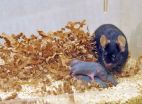(Press-News.org) COLUMBUS, Ohio - Seven out of 10 college students feel stressed about their personal finances, according to a new national survey.
Nearly 60 percent said they worry about having enough money to pay for school, while half are concerned about paying their monthly expenses.
The findings suggest that the pressures of student loan debt and finding ways to make ends meet are weighing on America's college students, said Anne McDaniel, co-author of the study.
In fact, 32 percent of students reported neglecting their studies at least sometimes because of the money they owed.
"The number of students feeling financial stress is striking," said McDaniel, who is associate director of research and data management at The Ohio State University's Center for the Study of Student Life.
"We need to help students manage their stress so they can be conscientious about their financial decisions, but not so overwhelmed that it hurts their academics or health," added co-author Catherine Montalto, an associate professor of human sciences at Ohio State.
The findings come from the National Student Financial Wellness Study, which surveyed 18,795 undergraduate students at 52 colleges and universities across the country. It included students from four-year and two-year private and public institutions.
The study was conducted by a research team from Ohio State's Office of Student Life and College of Education and Human Ecology.
The survey found that despite the stress of paying for college, more than three-quarters of students think college is a good investment for their financial future and believe they will be able to support themselves after graduation.
"Students feel good about their decision to go to college and think it will pay off in the end," Montalto said.
While there has been a lot of research about student loan debt and default rates, this survey fills a gap by exploring the day-to-day financial lives of college students, said study co-author Bryan Ashton, assistant director of Ohio State's Student Life Student Wellness Center.
"This survey was designed to give a more comprehensive picture of the financial lives of students beyond just their debt levels and loans," he said. "We wanted to find out more about how they were managing their financial lives on a daily basis."
The survey found that 64 percent of college students used loans to help pay for college, which is similar to what other studies have found. Students also indicated a willingness to borrow more to finance their college education if they expected higher starting salaries upon graduation.
When asked how they paid for their tuition, students were most likely to say either loans or scholarships and grants (35 percent each).
While parents and family were mentioned as the primary source of funding for housing and books, 17 to 19 percent of students said they relied mostly on loans.
For those with loans, nearly one-third owed less than $10,000. But one in five owed more than $30,000.
When asked how much student loan debt they expected to have at graduation, the most common response (24 percent) was between $30,000 and $50,000. But 14 percent of responding students expected to owe between $50,000 and $80,000 and 7 percent thought they would owe more than $80,000.
McDaniel said she was concerned by how many students with loans borrowed right up to their limit.
"About 30 percent of students with loans said they borrowed the maximum amount for which they qualify each year, which may not always be the best choice," she said.
"But the good news is that about half the students with loans said they tried to borrow as little as possible."
Most students seem to have a good handle on credit card debt, the survey showed.
About 43 percent of students don't have a credit card and, of those who do, nearly half (47 percent) pay off the full balance each month. Of those who don't pay off the full balance, the majority (55 percent) owe less than $1,000.
However, a sizable minority (8 percent) owe more than $3,000 after their monthly payments.
Financial problems lead some students to make difficult choices, the survey found. Nearly three out of 10 students said they reduced their class load because of the money they owed, while 16 percent took a break from their college or university and 13 percent transferred to another institution.
Still, the students generally felt good about how their finances would turn out in the long run.
Nearly 8 out of 10 said they believed they would be able to pay off any debt they acquired while they were still in school and 67 percent said that, when they thought about their financial situation, they were "optimistic about their future."
Montalto said the survey results reported here are just the beginning of a long-term project. The Ohio State researchers will use the data to dig deeper into the financial wellness of college students, looking at the links between student borrowing, stress, graduation and other factors.
They plan to do another survey in two years with a larger group of participating institutions.
INFORMATION:
Other members of the research team are Kirstan Duckett, a research analyst, and Alicia Croft, a former graduate research assistant, both in the Center for the Study of Student Life.
A new Cochrane systematic review published today of surgery for stress urinary incontinence makes an important contribution to an ongoing debate and will help women to make more informed choices about treatment. Inserting a 'mid-urethral sling', a type of tape, to support the muscles of the bladder by either the groin or abdomen results in similar cure rates. However, differences in complications and the long term need for repeat surgery mean that women will need to balance a number of different factors when choosing an operation.
Stress urinary incontinence (SUI) is ...
BLOOMINGTON, Ind.--A new study from Indiana University provides evidence in mice that males may play a positive role in the development of offspring's brains starting before pregnancy.
The research, reported July 30 in the Proceedings of the Royal Society of London B: Biological Sciences, found that female mice exposed to male pheromones gave birth to infants with greater mental ability.
"This is the first study to show that pheromone exposure exerts an influence across generations in mammals," said Sachiko Koyama, an associate research scientist at the IU Bloomington ...
DARIEN, IL - A new study suggests that there may be a reciprocal, causal pathway between job strain and disturbed sleep, implying that interventions to treat sleep problems may improve work satisfaction.
Results show that higher work demands predicted subsequent sleep disturbances at the two-year follow-up. Similarly, sleep disturbances predicted a higher perception of stress, higher work demands, a lower degree of control, and less social support at work two years later. No relationship was found between disturbed sleep and physical work environment, shift work schedules ...
An international research team led by the University of Colorado Boulder and the University of Witwatersrand in Johannesburg, South Africa has discovered a milk-and ochre-based paint dating to 49,000 years ago that inhabitants may have used to adorn themselves with or to decorate stone or wooden slabs.
While the use of ochre by early humans dates to at least 250,000 years ago in Europe and Africa, this is the first time a paint containing ochre and milk has ever been found in association with early humans in South Africa, said Paola Villa, a curator at the University ...
NASA's Swift satellite detected a rising tide of high-energy X-rays from the constellation Cygnus on June 15, just before 2:32 p.m. EDT. About 10 minutes later, the Japanese experiment on the International Space Station called the Monitor of All-sky X-ray Image (MAXI) also picked up the flare.
The outburst came from V404 Cygni, a binary system located about 8,000 light-years away that contains a black hole. Every couple of decades the black hole fires up in an outburst of high-energy light, becoming an X-ray nova. Until the Swift detection, it had been slumbering since ...
June 30, 2015 - Two migraine surgery techniques targeting a specific "trigger site" are both highly effective in reducing the frequency and severity of migraine headaches, according to a randomized trial in the July issue of Plastic and Reconstructive Surgery®, the official medical journal of the American Society of Plastic Surgeons (ASPS).
Patients with temporal-type migraine derive similar and significant improvement from techniques that relieve pressure on (decompression) or remove a portion of (neurectomy) the nerve responsible for triggering their headaches, ...
A new University of Colorado Boulder framework used to screen hundreds of organic chemical compounds used in hydraulic fracturing, or fracking, shows that 15 may be of concern as groundwater contaminants based on their toxicity, mobility, persistence and frequency of use.
Using a fast groundwater transport scenario, the team predicted that 41 of the 659 organic compounds screened would have 10 percent or more of their initial concentrations remaining at a transport distance of roughly 300 feet. That is the average state "setback" distance in the United States between ...
Researchers at University of California, San Diego School of Medicine have discovered a cell signaling pathway that appears to exert some control over initiation and progression of colorectal cancer, the third leading cause of cancer-related death in the United States. A key protein in the pathway also appears to be predictive of cancer survival rates.
The study is reported in the June 30 issue of eLife.
The protein, known as Dishevelled-associating protein with a high frequency of leucine residues or Daple, is produced by nearly all healthy cells in the body and is ...
Brigham and Women's Hospital finds that developing and implementing an interdisciplinary care improvement initiative improves outcomes.
Approximately 20 percent of all patients admitted to a hospital have a mental health condition, either as a primary or a secondary diagnosis, and a recent report by the Institute of Medicine warned that there is a critical shortage of health care professionals who are equipped to provide mental health and geriatric care to these patients in the hospital setting. Often, these patients experience delirium, alcohol withdrawal and suicide ...
The universe can be a very sticky place, but just how sticky is a matter of debate.
That is because for decades cosmologists have had trouble reconciling the classic notion of viscosity based on the laws of thermodynamics with Einstein's general theory of relativity. However, a team from Vanderbilt University has come up with a fundamentally new mathematical formulation of the problem that appears to bridge this long-standing gap.
The new math has some significant implications for the ultimate fate of the universe. It tends to favor one of the more radical scenarios ...


